Los Angeles Kings: Top 10 prospects entering 2018


The Los Angeles Kings are not the team they were five years ago. After years of missing the playoffs and a sweep at the hands of an expansion team, the Kings need to rebuild. Here are the prospects who can help start that project.
The Los Angeles Kings are a team in need of a rebuild around their current core. Instead, they’ve been retooling, which has led to missing the playoffs and getting swept. Still, they’ve collected a good number of prospects for their efforts, and those prospects could come in handy over the next few seasons.
These prospects are ranked based on three categories: NHL readiness, the likelihood they play with the Kings, and, chief amongst these, ceiling. Prospects who have a combination of these or are higher than the others in one of them will rank higher. To qualify, each of these players must not have played 25 games in the NHL. That means that younger players like Alex Iafallo and Adrian Kempe are off the list.
More from Puck Prose
- Detroit Red Wings 2023 Rookie Camp Has Plenty of Ups and Downs
- This Columbus Blue Jackets rookie doesn’t want to be forgotten
- 2 trades the Boston Bruins must make to secure the Stanley Cup
- 3 reasons the Avalanche won’t win the Stanley Cup in 2024
- This is a big year for Alex Turcotte and the Los Angeles Kings
Let’s start with the goaltenders.
1. Cal Petersen [23] (5-129, 2013)
Stats (Ontario Reign, AHL): 41 gp, 2.58 GAA, .910 SV%, 4 SO (4 pgp, 2.38 GAA, .915 SV%).
Cal Petersen isn’t the greatest goaltender in the AHL. He’s not the best goaltending prospect in the National Hockey League. Yet, Petersen the best long-term prospect the Los Angeles Kings currently have and should be better in the future. Who knows, he could turn into one of the best goaltending prospects in the league. After all, goaltenders are voodoo and things change quickly.
Petersen was tied for 25th in save percentage in the AHL (amongst qualified goaltenders) but was fifth amongst rookies. He was 19th in goals-against average, but fourth amongst rookies. He was tied for first in shutouts for rookies and seventh for all qualified. Then in the playoffs, he was second in save percentage amongst rookies and second in goals-against average. That does give an indication that Petersen can be something, and something special.
He had four shutouts in the regular season as well, and that shows that Petersen can at times be dominant
He had four shutouts in the regular season as well, and that shows that Petersen can at times be dominant. At 23, there’s time for him to develop that dominance and to begin to excel as a prospect.
With Jonathan Quick still at an age where he can play a ton, Petersen isn’t in a rush. If he can continue to take steps forward, he’ll become that top-tier prospect, and perhaps eventually the Los Angeles Kings’ workhorse.
2. Matt Villalta [19] (3-72, 2017)
Stats (Sault Ste. Marie Greyhounds, OHL): 49 gp, 2.58 GAA, .908 SV%, 3 SO (24 pgp, 3.30 GAA, .893 SV%, 1 SO).
Matt Villalta was 11th in save percentage, third in goals against average, and tied for third in shutouts in the regular season in the OHL. At 19, those numbers could be better. Luckily, he has another season with the Greyhounds to prove that he can be better. He won’t be moved to the NHL quite yet, and he won’t be able to move to the AHL. Still, as a developing goaltender, another season in the OHL could be perfect.
if he can take steps forward as a goaltender in the next few seasons, he could put himself in position to be a piece of the Los Angeles Kings’ future
In the playoffs, Villalta was tied for first in playoff shutouts, tied for 13th in goals against average, and was 13th in save percentage. Villalta helped the Greyhounds get to the OHL finals, but lost to the Hamilton Bulldogs.
He was on the Third All-Star Team in the regular season, though again, he could be much better. He had the lowest team GAA (the Dave Pinkney Trophy) in the regular season, though that could be a product of the defense in front of him (which included Conor Timmins and Rasmus Sandin).
He’s of NHL size (6’3″) and if he can take steps forward as a goaltender in the next few seasons, he could put himself in position to be a piece of the Los Angeles Kings’ future. His ceiling is hard to determine (as it is with most young goaltenders), and he’ll need to make an AHL transition to see if he’ll play with the Kings.
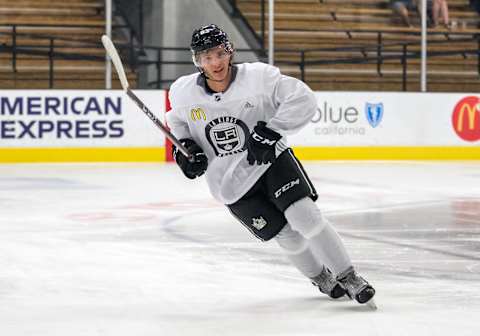
10. Brad Morrison, C [21] (4-113, 2015)
Stats (Vancouver Giants/Lethbridge Hurricanes, WHL): 74 gp, 27 g, 48 a, 75 p, 11 PPG (13 A), 2 GWG, 170 SOG, 50.5 FO%, 1.01 pts/g (16 pgp, 16 g, 21 a, 37 p, 4 PPG (13 A), 1 SHG (1 A), 3 GWG, 69 SOG, 2.31 pts/g).
Brad Morrison was, if anything, average in the OHL in the regular season. He was tied for 38th in scoring, 53rd in goal scoring, 35th in assists, and 56th in points per game. He was just one point over a point-per-game pace. He had an average faceoff percentage with relatively few faceoffs and had average shot production (2.3 shots per game). He was better on the power play than average, getting 24 points, but everywhere else… average.
An incredibly notable switch that he flipped, that made him be one of the driving forces of the Lethbridge Hurricanes in the playoffs
And then he flipped a switch in the postseason. First in playoff scoring, tied for second in goal scoring, second in assists, and third in points per game (though second in points per game with more than one game played). An incredibly notable switch that he flipped, that made him be one of the driving forces of the Lethbridge Hurricanes in the playoffs. 37 points in 16 games. If it was up to him and him alone, Lethbridge might not have been eliminated from the playoffs.
That’s why Morrison is number 10 on this list. He didn’t impress in the regular season, but he was perhaps the most impressive player in the playoffs. That serves as a good indication of what he can become, and the Los Angeles Kings surely liked it, signing Morrison to an entry-level deal. He has more to prove in the AHL, but he could rise up the list with a regular season as good as his postseason.
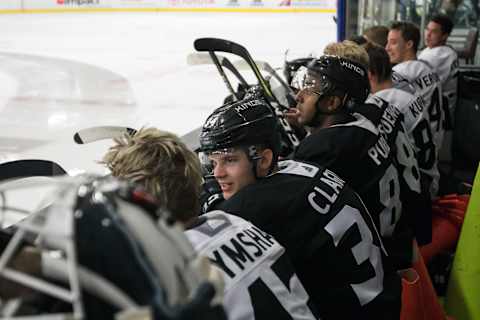
9. Bulat Shafigullin, LW [18] (3-82, 2018)
Stats (Neftekhimik Nizhnekamsk, KHL): 17 gp, 0 g, 2 a, 2 p (1 pgp, 0 g, 0 a, 0 p); 22 gp, 20 g, 16 a, 36 p (9 pgp, 4 g, 11 a, 15 p). Reaktor Nizhnekamsk, MHL
Bulat Shafigullin was very low on the consensus draft board but was taken much higher than that. He’ll serve as an example of whether draft analysts know more than scouts, and while he was impressive in the MHL this past season, his KHL numbers across the board, including his possession numbers and production numbers, both were lacking. At the professional level, considering the damage he did in the developmental league, that’s a bad thing.
He could be a replacement to somebody like Dustin Brown or Ilya Kovalchuk down the road
Still, more than a point per game in the MHL doesn’t lie, and some of the best players in the last few drafts have done worse at that level than Shafigullin. However, his skating and defensive game need work, and while he’s a natural sniper and can make plays, those skills didn’t translate to one of the best leagues in the world. Shafigullin will need to be more impressive in the KHL next season before making a successful transition to the AHL to become a member of the Los Angeles Kings, and those are big questions.
But with his MHL numbers, Shafigullin could do it. The Kings also need more depth on the wings, as well as younger players for the future, and if Shafigullin could make that transition, that would mean a bigger role with the Kings. He could be a replacement to somebody like Dustin Brown or Ilya Kovalchuk down the road, someone to pair with a playmaking center to finish plays.
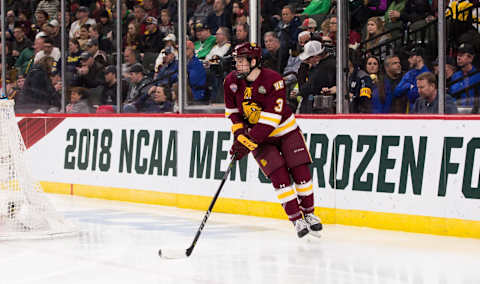
8. Mikey Anderson, D [19] (4-103, 2017)
Stats (University of Minnesota-Duluth, NCAA): 39 gp, 5 g, 18 a, 23 p, 3 PPG, 1 SHG, 1 GWG.
Mikey Anderson is a young defenseman who had better numbers than a lot of other defensemen in the Kings’ pipeline in a harder league. The NCAA might be the hardest developmental league in North America (and perhaps the world) and Anderson did well, even as a Freshman. He was tied for 41st in scoring amongst defensemen, 41st in assists, 54th in goal scoring, and was tied for 55th in points per game.
Anderson was good on the power play, good shorthanded, and played extended minutes with one of the finest NCAA teams
Anderson was good on the power play, good shorthanded, and played extended minutes with one of the finest NCAA teams. Up against stiff competition, Anderson did well, and he should do even better next season. As he continues to get used to higher-end competition and develops into an even better defenseman, Anderson should continue to put up quality numbers.
If he continues to grow, his ceiling could rise. Right now, he’s not NHL ready and doesn’t stand a significant chance of playing for the Los Angeles Kings. If he grows, that changes. Anderson was a fourth-round pick just last season, and while he’s still got years ahead of him before the NHL, he might already be worth that 103rd overall pick.
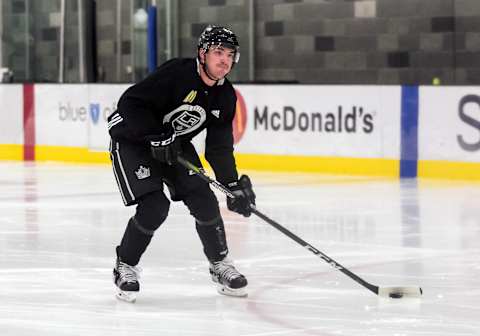
7. Mikey Eyssimont, LW [21] (5-142, 2016)
Stats (St. Cloud State University, NCAA): 39 gp, 17 g, 22 a, 39 p, 5 PPG, 4 GWG;
Stats (Ontario Reign, AHL): 3 gp, 0 g, 1 a, 1 p, 2 SOG, .33 pts/g.
Mikey Eyssimont was another solid NCAA player. Funny how the Los Angeles Kings mostly have prospects there, where they can keep a closer eye on them and have them face stiff competition. Eyssimont was up against fellow Kings prospects like Daniel Brickley and Mikey Anderson and still drove production with a point per game pace and five power-play goals. He’s an excellent scorer and a fine playmaker, and that could mean good things for the Kings’ middle six.
He’ll make the professional transition this upcoming season, where he’ll prove what he can be at this level
Eyssimont was tied for 33rd in scoring, 29th in goal scoring, 54th in assists, and 43rd in points per game this past season. With one of the better smaller programs in the country, those are excellent pole positions. He’ll make the professional transition this upcoming season, where he’ll prove what he can be at this level. It will be one of his most important seasons, especially in the eyes of the Los Angeles Kings.
Eyssimont has already played a few games with the Ontario Reign, adding one assist as he made the adjustment. With just two shots on goal, he’ll need to be better as he gets a full look at the AHL. If he can be, that’s another possible addition to the Kings’ middle six.
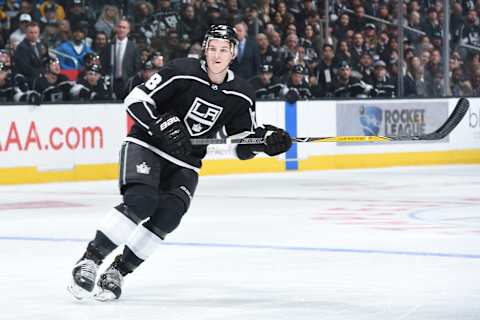
6. Daniel Brickley, D [23] (UDFA)
Stats (Minnesota State University-Mankato, NCAA): 40 gp, 10 g, 25 a, 35 p, 5 PPG, 2 GWG;
Stats (Los Angeles Kings, NHL): 1 gp, 0 g, 1 a, 1 p.
Daniel Brickley was one of the finest defensemen in the NCAA and then came in and impressed in an NHL game. While he’ll likely be relegated back to the AHL for a season to make a full-time professional transition, the Kings saw enough in him to both sign him and play him. That’s a good sign for the chances he plays with the Los Angeles Kings, and he’s one of the more NHL-ready defensemen in the Los Angeles pipeline.
the Kings saw enough in him to both sign him and play him
Brickley was tied for 51st in the NCAA scoring, and fifth amongst defensemen, 28th in assists (seventh amongst defensemen), 83rd in points per game (11th amongst defensemen) and was seventh amongst defensemen in goal scoring. One of the better offensive defensemen whilst playing in one of the better conferences shows that Brickley can likely play full-time in the NHL.
But he’ll take a season to develop, and while his NHL readiness is there, the Kings don’t have the room right now. His ceiling isn’t that high (at most a fourth defenseman), but he’s very likely to get extended time with the Kings. Brickley has already shown that he’s capable of much more than playing in the NCAA, and it’s just about proving it over an extended period.
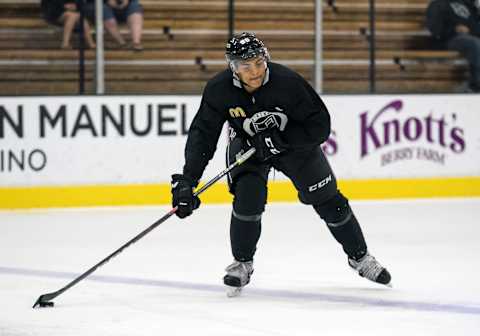
5. Akil Thomas, C/W [18] (2-51, 2018)
Stats (Niagara IceDogs, OHL): 68 gp, 22 g, 59 a, 81 p, 6 PPG (26 A), 1 SHA, 3 GWG, 198 SOG, 53.4 FO%, 1.19 pts/g (10 pgp, 5 g, 6 a, 11 p, 2 PPG (4 A), 1 GWG, 31 SOG, 47.6 FO%, 1.10 pts/g).
Akil Thomas was projected by many to go in the first round of the 2018 entry draft. Yet, like the prospect immediately ahead of him, Thomas wound up going pretty late in the second round. It might be because of his postseason, it might be because of his goal scoring. Yet Thomas is an incredibly skilled prospect, one who might wind up being a steal for the Los Angeles Kings.
Related Story. One Reason For Optimism For Each Team. light
Thomas has a lot of skills that need work. His skating form is far from perfect, but he’s got impressive speed. His shot production is lacking (2.91 shots per game), perhaps because of selfless instincts. He plays most of his time on the perimeter, setting up plays and letting his teammates do the scoring. That facilitator type of game is an incredibly important aspect of the game for a center, but he needs to learn to shoot and score more. Especially because he shows promise in that category.
He was fifth in assists, 22nd in points per game, and 14th in scoring in the OHL. Even with a less talented Niagara IceDogs team, Thomas impressed. He helped Canada win the Hlinka Gold Medal, and was on the OHL First All-Rookie team last season. He’s got more to prove down the road, but he has the skill to prove it, he just needs more developmental work.
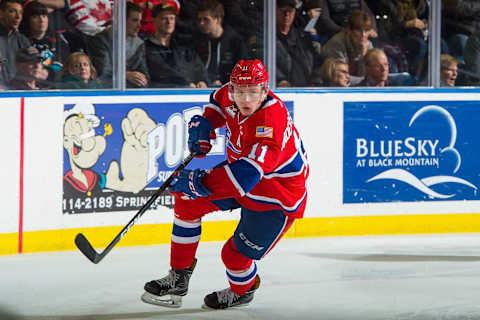
4. Jaret Anderson-Dolan, C [18] (2-41, 2017)
Stats (Spokane Chiefs, WHL): 70 gp, 40 g, 51 a, 91 p, 13 PPG (17 A), 5 SHG (2 A), 5 GWG, 280 SOG, 52.9 FO%, 1.30 pts/g (7 pgp, 2 g, 7 a, 9 p, 1 PPG (2 A), 29 SOG, 63.6 FO%, 1.29 pts/g);
Stats (Ontario Reign, AHL): 5 gp, 0 g, 2 a, 2 p, 8 SOG, .4 pts/g (3 pgp, 0 g, 0 a, 0 p, 3 SOG).
Like Thomas, Jaret Anderson-Dolan was more impressive than his draft spot would show. He was thought to be a first-round pick, and the Kings are known to have gotten a steal. He was an impressive scorer all around in the WHL this past season, and while the Spokane Chiefs fell out of the playoffs quickly, that’s not because of Anderson-Dolan. He scored 91 points in 70 games in the regular season and nine in seven in the postseason. He then transitioned to the AHL and showed up as a playmaker.
Related Story. What if the Kings Kept Wayne Simmonds and Brayden Schenn. light
Anderson-Dolan was tied for 14th in scoring, 17th in goal scoring, 29th in assists, and 21st in points per game. In the playoffs, he was tied for 20th in points per game. That’s impressive, even for a player in his first post-draft season. He was excellent on the power play, solid on the penalty kill, and came up with five game-winning goals in 70 games. He also averaged four shots per game, won a good chunk of his faceoffs, and did even better in the playoffs. Everything the Kings should have wanted to see out of Anderson-Dolan this season they saw.
His ceiling is as the second in a one-two punch. The Jeff Carter to the best Kings prospect’s Anze Kopitar. With a September birthday, Anderson-Dolan did all of this while still being 18. He’s going to take another season in the WHL before transitioning to the AHL, but leaving on a high note of over 100 points is still perfect for someone the Kings expect great things out of. Anderson-Dolan should meet that perfectly reasonable goal, and one more – stay healthy. That’s all he’s gotta do.
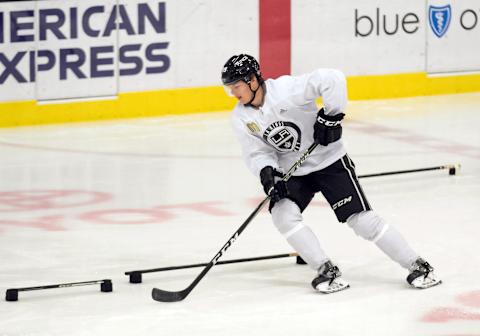
3. Rasmus Kupari, C [18] (1-20, 2018)
Stats (Karpat, Liiga): 39 gp, 6 g, 8 a, 14 p, 2 PPG (6 pgp, 0 g, 0 a, 0 p);
Stats (Karpat U20, Jr. A SM-ligga)11 gp, 3 g, 4 a, 7 p (3 pgp, 0 g, 2 a, 2 p).
Stats (Hermes, Mestis): 5 gp, 1 g, 3 a, 4 p.
Rasmus Kupari fell down the draft rankings as the season wore on, beginning as a top ten pick and ending as 20th overall. Still, the Los Angeles Kings saw enough in him to take him at that position, even despite the warnings draft analysts were giving. That means they like what they saw, even in the brief games Kupari played across multiple leagues, never topping a point per game pace in any of them. In the developmental league, he had seven points in 11 games. He played 39 games in the best league and came close to a point-per-game pace in Finland’s version of the AHL.
Related Story. Each Team's Worst Contract. light
Kupari didn’t do well in the AHL, scoring just two points in the Jr. A SM-liiga and scoring zero in six games in the Liiga. His numbers are genuinely confusing, but he didn’t have much time to get settled anywhere. He was playing against much older competition in the Liiga, which might explain his relative lack of numbers. Players who have gone through the Liiga at a young age like himself have had similar struggles. Even Patrik Laine, the best Finnish prospect in a long time, only scored 33 points in 46 games.
Kupari won’t be at Laine’s level, but then again, who is. If he’s a third-line center, that’s what the Kings need, especially if Anderson-Dolan and Gabriel Vilardi live up to the hype. He’s a solid playmaker who can shoot well, and while he’s still a number of years away, that should be okay. He’ll get more time in the Liiga this season before coming over to the AHL, and that could show more of what Kupari is capable of.
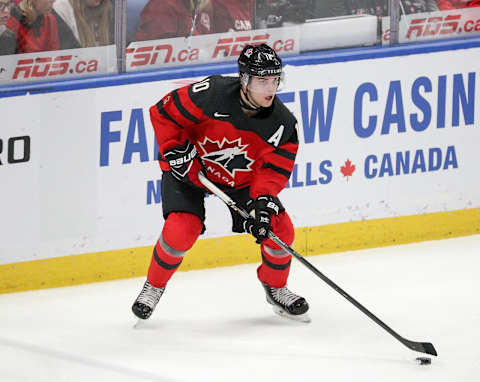
2. Kale Clague, D [20] (2-51, 2016)
Stats (Brandon Wheat Kings/Moose Jaw Warriors, WHL): 54 gp, 11 g, 60 a, 71 p, 5 PPG (25 A), 1 SHG (2 A), 182 SOG, 1.31 pts/g (14 pgp, 1 g, 13 a, 14 p, 1 PPG (8 A), 45 SOG, 1 pt/g).
Kale Clague played a shortened WHL season, missing about 18 games. Yet he was one of the best offensive defensemen in the league, and he has the stats to prove it. He was first in points per game, tied for third in scoring, was first in assists, and was tied for 20th in goal scoring amongst defensemen. In the playoffs, he was tied for eighth in defensive points per game, fourth in assists, and seventh in scoring. That sets him up for success at the professional level, where he’ll begin playing next season.
Trending. Which Number Should Each Team Retire Next?. light
Clague should be a top-four defenseman, somebody who quarterbacks one of the power-play units for the Los Angeles Kings. As Drew Doughty fades with age, Clague should be able to take some of his responsibility, especially offensively. That’s exactly what the Kings need for future success, and Clague can do it. He’s excellent on the power play already and was fine shorthanded. He’ll need work in the defensive zone in Ontario, but if he can develop quickly, he should be ready soon.
Hell, Clague could be on the bottom pairing this season. The Kings need a sixth defenseman, and with Alec Martinez and Jake Muzzin on the second pairing and Doughty and Derek Forbort potentially on the first, Clague could get some minutes playing with Dion Phaneuf. Somebody like Phaneuf, who could cover for Clague in the defensive zone while Clague carries possession and drives the offensive zone, that’s a perfect situation.
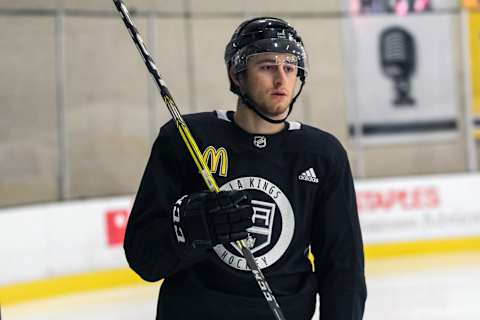
1. Gabriel Vilardi, C/W [19] (1-11, 2017)
Stats (Kingston Frontenacs, OHL): 32 gp, 22 g, 36 a, 58 p, 7 PPG (11 A), 1 SHG (1 A), 113 SOG, 51.1 FO%, 1.81 pts/g (16 pgp, 11 g, 11 a, 22 p, 3 PPG (6 A), 4 GWG, 56 SOG, 50.9 FO%, 1.38 pts/g).
Should have been a top-five pick, but fell to the Los Angeles Kings at ten. Was second in points per game in the OHL, but only played 32 games. Was excellent in the playoffs, after getting healthy for the first time this season. Should be able to make the jump to the NHL, but there’s currently no room, and the Kings may want to see more in the OHL. Gabriel Vilardi is having a complicated, complex road to the NHL. But his is a path that will lead to the NHL, and one that could lead to more than that, even being a star.
Vilardi has areas of his game he needs to work on. His faceoff percentage was low, just 51.1%. He needs to continue to work on his defensive game, but he drives possession well and has excellent awareness. He doesn’t have perfect skating, but he gets around effectively and powerfully. Vilardi does everything he needs to at a high level and should be an important figure in the future of the Los Angeles Kings. He also needs to work on his health, as he’s missed time in both of the last two seasons. That’s not what the Kings need out of their future star.
Next. 3 Key Kings For Next Season. dark
Vilardi is at most two seasons out from being an impact player for the Los Angeles Kings. By all rights, he should be a player for the team. He’s got a high ceiling, including the possibility of being a first-line center. That’s why he’s on top of this list. He’s got the highest ceiling and perhaps the best likelihood of playing for the Kings, even if he’s a few seasons out.